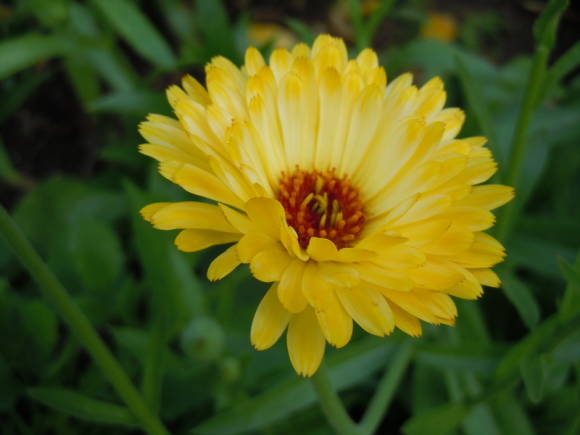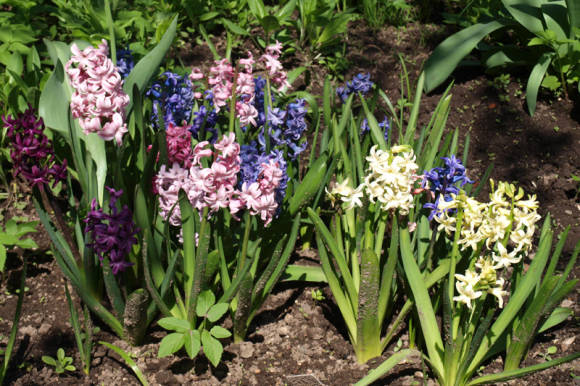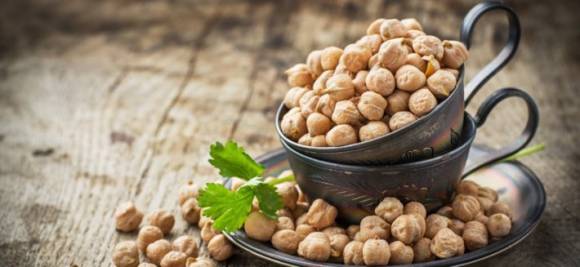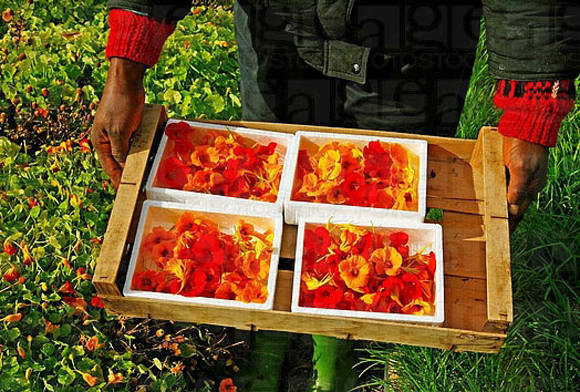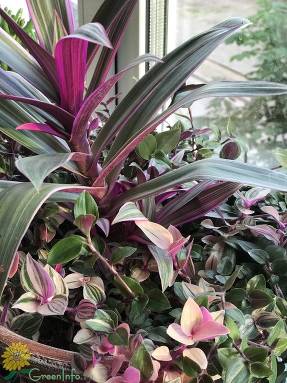
If you do not have a summer cottage or garden area, but really want to try to grow something with your own hands, then in the summer you can use a balcony or loggia as a home greenhouse. If they are glazed and insulated, then you can grow plants from early spring to late autumn.
Tomato is perhaps one of the most unpretentious "balcony" crops. In addition, this plant is very productive and, at the same time, decorative. With skillful care, your own plantation will not only provide you with fragrant fruits, right from the garden, but also delight the eye with a scattering of "berries" reddening among the bright greenery.
Read about the choice of varieties in the article Varieties of tomatoes for the balcony.
Sowing time of tomato for insulated balconies and loggias is early March, for open balconies - late March - early April.
Growing seedlings
Seedlings are best grown in separate pots or cassettes. When filling the earth coma with roots, transfer from a small container to a large one, deepening the seedlings almost to the cotyledon leaves. In this way, a good root lobe is formed.
O growing tomato seedlings read the article Growing tomatoes in the garden.
The grown seedlings are transferred together with a lump of earth into larger pots or planted in boxes. One plant needs about three liters of soil. For tall plants, the required volume of soil is 5-7 liters. In pots and boxes, it is imperative to make drainage to remove excess moisture from the roots. A layer of expanded clay or small pebbles is laid on the bottom with a layer of 2-3 cm, the bottom should also have holes for draining water. Tomatoes do not like excess moisture and do not tolerate stagnant air. Therefore, you need to put boxes and pots for better ventilation of plantings for supplies, hanging pots are also good. Tomatoes are not afraid of drafts.
Accommodation on the balcony

Tomato is a light-loving culture. Northern balconies are not suitable for cultivation. Southeast and south are ideal. It is very hot on the south-western balconies in the summer heat, therefore, when growing tomatoes on them, it is necessary to shade the plants on hot days and be sure to ventilate.
As soon as weather conditions permit (for glazed balconies and loggias - in early to mid-April, for open balconies - in early May), tomatoes are put on the balcony. With a sharp decrease in temperature to minus, cover with a non-woven covering material. Caring for tomatoes on the balcony is the same as in a greenhouse.
The optimum temperature is + 25 + 28 ° С in the daytime and +15 ... + 16 ° С at night. Before flowering and fruiting, the temperature can be 2-3 ° C lower. Soil temperature should be at least +17 ... + 20 ° С. They regulate the air temperature by ventilation by opening doors and balconies. Airing is mandatory 2-3 hours after watering, especially during the flowering period. During flowering, humidity should not exceed 65%.
Watering and feeding
Tomatoes tolerate direct sunlight well and suffer from a lack of light. Only in very hot weather should plants be protected from direct sunlight. Watering tomatoes should be rare, as the soil dries up (no more than 2 times a week), but abundantly, completely wetting the soil. Better to water in the morning with warm water (+20 ... + 25 ° C). If the tomatoes are planted in boxes, water the soil around the bush, not under the bush. After watering, as soon as the soil dries up a little, it is loosened, which slows down the evaporation of moisture from the soil and provides air to the roots. Simultaneously with loosening the soil, the plants spud, which contributes to the formation of new roots. If the soil has settled, you can add a layer of fresh peat or nutrient mixture on top.
Tomatoes are fed with a solution of mineral fertilizers; if necessary (in case of weak growth), organic matter can be used, for example, mullein (1: 5) at the rate of 1 liter of solution per plant.
The first feeding with complex mineral fertilizers (30 g per 10 l of water) is carried out a week after planting the seedlings in a permanent place. The rest of the dressing is done at intervals of 10-12 days, mainly during the fruiting period.
Foliar dressing gives good results, i.e. spraying the leaves with a nutrient solution. They promote better plant growth and development and prevent shedding of flowers.
Bush formation
It is better to form low-growing tomatoes grown on the balcony into 2-3 stems, for which, in addition to the first stepson, the second stepson is also left. Tall tomatoes form into one stem, breaking off all stepsons.
Tomato stems are brittle, therefore, as the seedlings grow, the plants are tied to stakes or to a trellis. Recently, the so-called "ampelous" varieties of tomato have appeared, which do not require a garter. In fact, "ampelous tomatoes" are not new varieties, but an idea: If you leave 2, maximum - 3 shoots in the upper part of the cherry tomato stem, they will hang very picturesquely from the pots. The main thing is not to take too powerful and standard tomatoes for this. The latter have a strong stem, consisting of short internodes, which remains upright for a long time.
During the entire growing period, it is necessary to remove the shoots developing in the leaf axils. Without pinching, the plants are thickened, less illuminated and do not lay inflorescences. A good harvest from such bushes cannot be harvested. To avoid infection of plants with viral diseases, stepchildren do not cut it off, but break it off with their fingers, trying not to damage the main shoot and leaves, leaving columns 2-3 cm high.This operation is best done in the morning, when stepsons break off easily.
Sick and yellowed leaves, as well as leaves covering the fruits of the lower brushes of the plant, when these brushes are fully formed, are also promptly removed.
Flowering and fruiting

Tomatoes are a self-pollinating culture, they do not need artificial pollination, but for better fruit setting in cloudy and calm weather, you can slightly shake the flower brushes several times a day during the flowering period so that the pollen from the upper flowers spills out onto the flowers located below. In order for pollen to germinate on the stigma of the pistil, immediately after pollination, it is necessary to water the soil or spray the flowers. During the flowering of the second and third brush, for better fruit setting, the plants are sprayed with a solution of boric acid (1 g per 1 liter of water). To prevent the flowers from dropping and to improve the quality of the fruit, flower clusters can be treated with growth stimulants.
After tying the bulk of the fruit, pinch the top of the main shoot. At the same time, all flower brushes are cut off, since the fruits on them will no longer have time to form.
To accelerate the formation and development of fruits, you can also use a technique called "tearing the roots". The plant is taken by the lower part of the stem and gently pulled upward, as if trying to pull it out of the soil in order to break off the small roots. Then the plant is watered and spud.
In healthy, strong plants, the upper leaves may curl slightly during the day, and straighten out at night - this is the norm. If the leaves of tomatoes are directed upward at an acute angle and do not curl day or night, the flowers and ovaries fall off, then the reason may be dry soil, high temperature, poor ventilation and low illumination of the plants.
With frequent watering and the introduction of a large amount of nitrogen and organic fertilizers into the soil, the plants "fatten" - powerful bushes with a thick stem and powerful stepsons grow, however, as a rule, a very weak flower raceme with a small number of flowers is formed. To straighten such plants, they are not watered for 7-10 days. In addition, to delay growth, it is necessary to make a foliar top dressing with superphosphate (3 tablespoons per 10 liters of water). Plants are watered with this solution at the rate of 1 liter per plant.
Diseases and pests of tomatoes on the balcony

The most common fungal disease in tomatoes is late blight, a sign of which is the appearance of dark brown merging spots on the leaves, stems and fruits. This dangerous disease can not only destroy the entire crop in a short time, but also spread to other indoor plants. Promotes the rapid development of the disease, which usually spreads in July-August, warm and damp. If by this time most of the fruits have already ripened, then at the first signs of late blight, it is better to immediately destroy diseased plants. In this case, unripe fruits should be dipped in hot water (+ 60 ° C) for 1.5-2 minutes, and then put in a dry, warm, dark place for ripening.
Read more in the article Late blight, or brown rot of a tomato.
Black leg seedlings are affected, its root collar darkens, becomes thinner and rots. The plant withers and dies. The disease spreads with plant debris, lumps of soil, partly with seeds. Control measures are moderate watering of the plants, not thickened sowing, for the prevention of the disease, Trichodermin is introduced into the soil before planting (preferably in a mixture with Ecogel).
Root rot of tomatoes (anthracnose) Is a very dangerous disease. Sick plants wither, their root collar rots. Cucumbers also suffer from the same disease. It is necessary to thoroughly disinfect the soil with a solution of copper sulfate; if possible, it is advisable to remove the infected topsoil and add a fresh one. Sick plants can be watered with the "Barrier" solution, add the "Barrier" preparation. But it is better to prevent this disease using a mixture of Alirin or Gamair with EcoGel.
At the end of the growing season, with the onset of cold rainy weather, tomatoes can be affected gray mold... Small, rounded spots appear on green or red fruits. They then grow larger and become watery. The causative agent of gray rot can also develop on other terrestrial organs (stems, leaves, flowers), they are also covered with gray mold. It is necessary to delete affected fruits and plants; increase the air temperature if possible. When this disease spreads, the plants are destroyed, and the soil after growing the tomatoes is thrown away.
Brown rot (phomosis) develops only on tomato fruits in conditions of high humidity and excess nitrogen. Phomosis appears in the form of a small brown spot (about 3-4 cm) around the peduncle. Although it is not large on the surface, the inner tissue of the fruit is also exposed to rot. Green and red fruits are affected. Affected fruits destroy.
Cracking tomato fruit - physiological (non-infectious) disease. The reason is a sharp fluctuation in soil moisture. With abundant watering, the cell walls of the peel of the fruit do not withstand increased pressure and burst. Then the wounds dry out, the fruits turn red prematurely, not reaching their size. Control measures — moderate watering at intervals. Many modern hybrids have genetic resistance to fruit cracking.
With a lack of calcium in the soil and an excess of nitrogen in arid conditions, the likelihood of damage to tomatoes is high. top rot. On still green fruits, small watery or dry black spots with a rotten smell appear. To prevent this disease, regular watering and moderate nitrogen fertilization are necessary. Infected plants are sprayed with a solution of calcium nitrate (1 tablespoon per 10 liters of water), the affected fruits are destroyed.
Spider mite lives on the underside of leaves, sucking out cell sap and braiding the leaf with a thin web. At the beginning of the damage, light dots appear on the leaf, then discoloration of the leaf area (marbling) occurs and the leaves begin to dry out. Flowers and leaves fall off. Treatment of plants with Fitoverm (1 ml per 1 liter of water) is effective against ticks. You can fight the mite by spraying with infusions of onion or garlic husks (200 g of husk per 1 liter of water).
Whitefly - a small insect 1-1.5 mm long with a yellowish body and two pairs of powdery white wings. The larvae are flat, oval, pale green in color. They stick to the leaves, sucking out the juice. The affected areas of the plant are inhabited by sooty fungi. The leaves become covered with black bloom, dry up, and the plant dies. Control measures — processing by Confidor or Mospilan. Plants are sprayed in the morning or evening hours. During the season, it is recommended to carry out 2 treatments with an interval of 15-20 days.

